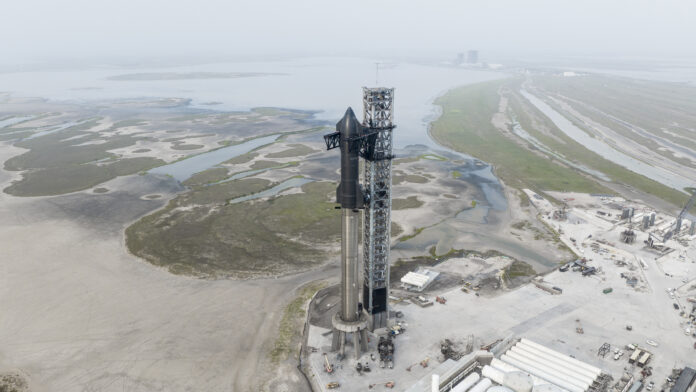After two previous test flights ended in fiery explosions, SpaceX is readying its next attempt to launch the massive Starship rocket on an ambitious multi-hour journey around the Earth. This upcoming launch, targeted for Thursday morning from the company’s Starbase facility in Boca Chica, Texas, represents a critical step in validating Starship’s capabilities as a potential deep space transportation system.
The stakes are immense for the private space company and its founder, billionaire Elon Musk. Starship represents SpaceX’s multibillion-dollar moonshot to develop a fully reusable launch system capable of ferrying cargo and crews to the Moon, Mars and other distant destinations. A successful flight test could inch Starship closer to operational reality and SpaceX’s long-term ambitions of establishing a permanent human presence on the Red Planet.
We’re really looking for a major increase in performance from this third Starship launch,” said Gwynne Shotwell, SpaceX’s president, in a pre-launch briefing. “The previous tests provided invaluable data, but we’re eager to take the next big leap and actually get the vehicle into orbital trajectory, even if it’s just for a brief period.”
Shotwell added that while SpaceX is targeting orbital velocities on this launch, the primary goals are to test critical in-flight maneuvers and procedures at extreme velocities and acceleration forces. Clearing these hurdles would mark a “Wright brothers moment” in the development of Starship as an interplanetary spaceship.
At nearly 400 feet tall when stacked together, the full Starship launch system consisting of the massive first-stage Super Heavy booster and upper stage Starship spacecraft is designed to be the largest and most powerful rocket ever to fly. The Super Heavy booster alone generates a staggering 16 million pounds of thrust from its 33 Raptor engines, nearly double that of NASA’s powerful new Space Launch System moon rocket.
During launch, the Super Heavy booster will fire for approximately three minutes before separating. The Starship spacecraft’s six engines will then ignite in a choreographed maneuver known as “propulsive separation,” providing the thrust to escape Earth’s gravitational pull. After separating from the booster, Starship is expected to continue flying for around an hour while conducting multiple in-space engine restarts and potentially reaching orbital velocity.
Unlike the two prior Starship test flights in 2022, SpaceX does not intend for the upper stage vehicle to survive this mission intact. The plan calls for a controlled aerodynamic entry and breakup of Starship over the Pacific Ocean near the Hawaiian islands after achieving its test objectives.
“We’ll be pushing the boundaries of what this vehicle was designed for,” explained John Insprucker, SpaceX’s lead integration engineer for Starship. “Parts will undoubtedly break, but that’s the whole purpose – find the flaws, gather data, and make the necessary improvements for future flights.”
While not designed to reach orbit on this specific mission, Starship is ultimately intended to become the world’s first fully reusable transportation system for both Earth orbit and deep space voyages. The gargantuan booster and spacecraft are being developed with a stainless steel design that will allow both vehicles to be recovered after launch, refurbished and relaunched in a matter of weeks, potentially slashing the costs of access to space.
“We absolutely will get Starship into orbit later this year,” said Elon Musk in a livestreamed discussion leading up to the launch. “The path will be incredibly arduous and there’s a tremendous amount of risk, but this is the unwavering strategy to make human life multi-planetary and ultimately ensure the long-term survival of our species.”
In the nearer term, SpaceX is working under a $2.9 billion contract with NASA to modify Starship as a lunar lander for the space agency’s Artemis program. The goal is to utilize a version of Starship to deliver the first astronauts to the surface of the Moon in over 50 years as early as 2025. Musk stated Starship could also play a major role in establishing a permanent base at the lunar south pole aimed at proving out key technologies and operations to eventually carry astronauts to Mars by the end of the decade.
For Thursday’s launch attempt, SpaceX has a broad 110-minute window opening at 8:00 a.m. Eastern Time (7:00 a.m. local time) to get Starship airborne, with weather forecasts currently giving a 70% chance of acceptable conditions. Live coverage from the launch site near Boca Chica Beach will be streamed worldwide with expert commentary, including on SpaceX’s website and YouTube channel.
While the two prior Starship launch attempts in 2022 faltered within minutes due to uncontrolled booster debris strikes and overly extreme aerodynamic forces, the dramatic failures provided SpaceX a trove of vital data to analyze and tweak the vehicle’s design. It’s an iterative development approach pioneered by SpaceX that stands in contrast to traditional aerospace practices.
“Elon’s philosophy is to push the limits, gather as much data as possible from real flight tests, and use that data to improve,” said Insprucker. “It’s a very different development mindset versus overanalyzing everything on the ground through simulations, which can miss critical real-world factors.”
Local spectators have already begun staking out prime viewing locations near Boca Chica in anticipation of Thursday’s high-stakes launch attempt. Temporary road closures and safety perimeters from the Federal Aviation Administration will be in effect during the test flight due to the extreme power and experimental nature of the Starship vehicle.
If SpaceX can achieve all of its desired test objectives on this launch and verify Starship is on the right development path, the company says it will quickly press ahead with additional orbital flight tests later in 2023 as it chases the audacious goal of landing NASA astronauts on the Moon by 2025 and establishing transportation infrastructure to Mars before the decade is out.























